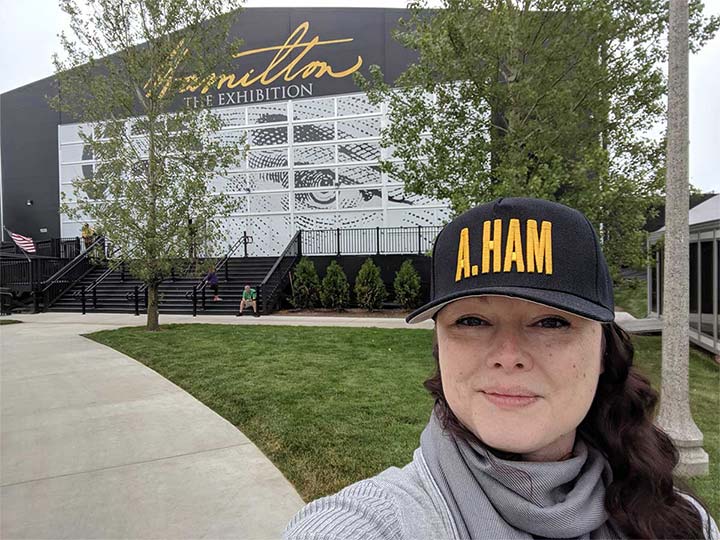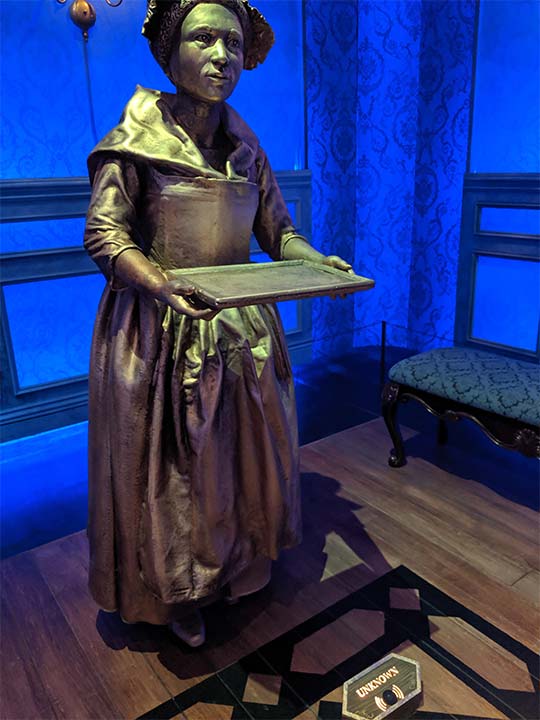Hamilton: The Exhibition – A Review

Rachael Cristine Woody
The following is my review of Hamilton: The Exhibition. The world premiere for the interactive exhibit took place in Chicago, on April 27, 2019. It is self-described as “the revolutionary interactive exhibit” and accords with the principles of museum DEAI (diversity, equity, accessibility, and inclusion).
An Introduction to the Exhibit
A spinoff from Lin Manuel Miranda’s Hamilton Musical, the exhibit is seen as an attempt to present all of the history that Lin Manuel Miranda couldn’t fit into the musical. Hamilton: The Exhibition describes via their website the nature of its exhibit:
- Featuring interactive games and displays, lifelike projections, full-scale statues, and Instagram-worthy art installations, Hamilton: The Exhibition takes visitors deeper into Alexander Hamilton’s life as it chronicles the American Revolution and the creation of the United States of America.
The temporary exhibit space measures 35,000 square feet and is composed of high-quality theatrical props, lighting, and an orchestral score to set the scene for each room. The exhibit takes a minimum of 45-minutes to walk through or as long as 3-hours, with 90-minutes being the suggested average time spent in the exhibit. There is a serpentine path that guides viewers through history and once patrons embark on the exhibit’s one-way path there is no easy way to exit (in a non-emergency). In fact, museum staff warn patrons to use the restroom before beginning.
Upon entry each viewer receives a headset with an audio tour that triggers as you enter each space. Each audio snippet is approximately 30-seconds to 2-minutes in length and provides brief contextual information for the content of that room. Narrators on the audio tour are actors from the Broadway production of Hamilton the Musical and Joanne B. Freeman, historical advisor and Professor of History and American Studies at Yale University. There are additional audio hot spots throughout the exhibit that viewers can elect to hear as they tour through.
Not Your Typical Museum
There are few truly historical items on display and many are reproductions. The reproductions are ensconced in traditional exhibit cases and even include mylar protections and temperature and humidity monitors. To the untrained eye (and if you skip the label) it would be easy to mistake them for the actual historical items. This may be disappointing to history buffs, but the conventional halls of remote items in stuffy cases will likely not be missed among the Broadway-quality sets and interactive historical displays. Not quite a museum and not quite a musical, this exhibit enters into new territory with what many are labeling as a risky move. However, the exhibit’s iconic styling and engaging educational design is compelling and offers several ideas for museums to consider if they wish to increase patron enjoyment via their exhibits.
Diversity and Equity
The exhibit presents the typical facts and stories we know of the era; however, it goes one step further by consistently inserting the under-represented stories of women, Native Americans, and enslaved peoples. Alongside the famous stories of Hamilton, Washington, and other Founding Fathers, we also hear the contextual history of what it was like for non-white-men at this moment in history. For example, in addition to broad facts about slavery, the exhibit provides stories from the perspective of previously nameless people. The exhibit does a laudable job of crafting fact-based perspectives for the other people in the room (where it happened) who did not have their histories captured or kept. Historically, museums have pointed to this lack of record as an excuse. Hamilton: The Exhibition offers a solution to this universal museum problem by using historical facts and context to craft a more representative and inclusive history.
One particularly evocative instance of the exhibit offering to help repair the flawed and selective history, is in the Revolutionary-era ballroom. In this room patrons hear the stories of the known historical players and are then presented with Unknown, a slave. In place of where her story should be, the exhibit audio challenges us to wonder about Unknown’s life by providing guided questions. This exercise helps the listeners to see first-hand the holes that remain in our historical fabric.
Accessibility
In addition to striving for diversity of stories within history, the exhibit is also accessibility conscious. The exhibit is ADA accessible and provides wheelchairs on a first-come, first-served basis. Sight-impaired visitors can request large-print versions of the exhibit copy and enjoy the audio tour. For those who are hearing-impaired, there are transcripts of the audio guide, closed-captioning on the videos, and sound amplifiers can be requested.
Inclusion
Finally, in both the opening and the closing of the exhibit, viewers are asked to consider themselves as part of the narrative—both past and present. As you enter, Miranda says “The story of America is your story too.” He goes on to affirm that it’s not just the Founding Fathers who made America. It was also immigrants, slaves, Native Americans, women, and the working class. At the end of the exhibit viewers are asked to participate by writing their thoughts and wishes for America on a post-it and adhering it to the exhibit wall. It’s an excellent reminder that we are all participants in this great experiment and that all of our stories are ones to be included.
The exhibit hopes to tour to other cities, but no schedule has been published at the time of this post. They suggest you follow them on Twitter, @HamExhibition for updates.

Rachael Cristine Woody stands outside Hamilton: The Exhibition wearing the iconic A. Ham baseball hat.

Unknown is a slave who stands among other historical figures in a Revolutionary-era ballroom. Her story is included alongside George Washington, the Schulyar sisters, and others.

Rachael Cristine Woody
Consultant, author, and blogger Rachael Cristine Woody advises on museum strategies, collections management and grant writing for a wide variety of clients. Read another DEAI related post of Rachael’s. Additionally, learn about Lucidea’s Argus solution for museum collections management and digitization, which can be used to support a wide variety of museum strategies.
Similar Posts
Exploring No-Code Digital Storytelling: Hoover’s “Fanning the Flames” Exhibit
Explore no-code digital storytelling with Hoover’s ‘Fanning the Flames’ exhibit. See how interactive tools (Deep Zoom Color Compare & Hot Spot) enhance user engagement and the visual experience.
An Introduction to Scrollytelling for Museums
Discover how museums use scrollytelling and digital storytelling platforms to create immersive narratives. This introduction explores key concepts and approaches to interactive storytelling.
Exploring Self-Determinate Multiple Pathways: An Example of Digital Storytelling
Discover how self-determinate multiple pathways offer flexible interactive storytelling in museum exhibits. Learn from the Tenement Museum’s ‘Your Story Our Story.’
Digital Museum Storytelling Example: A Look at Self-Determinate Linear Pathways
Self-determinate characteristics on a linear pathway go beyond brief sidebar topics and instead offer alternative ways to navigate the linear pathway.






Leave a Comment
Comments are reviewed and must adhere to our comments policy.
0 Comments